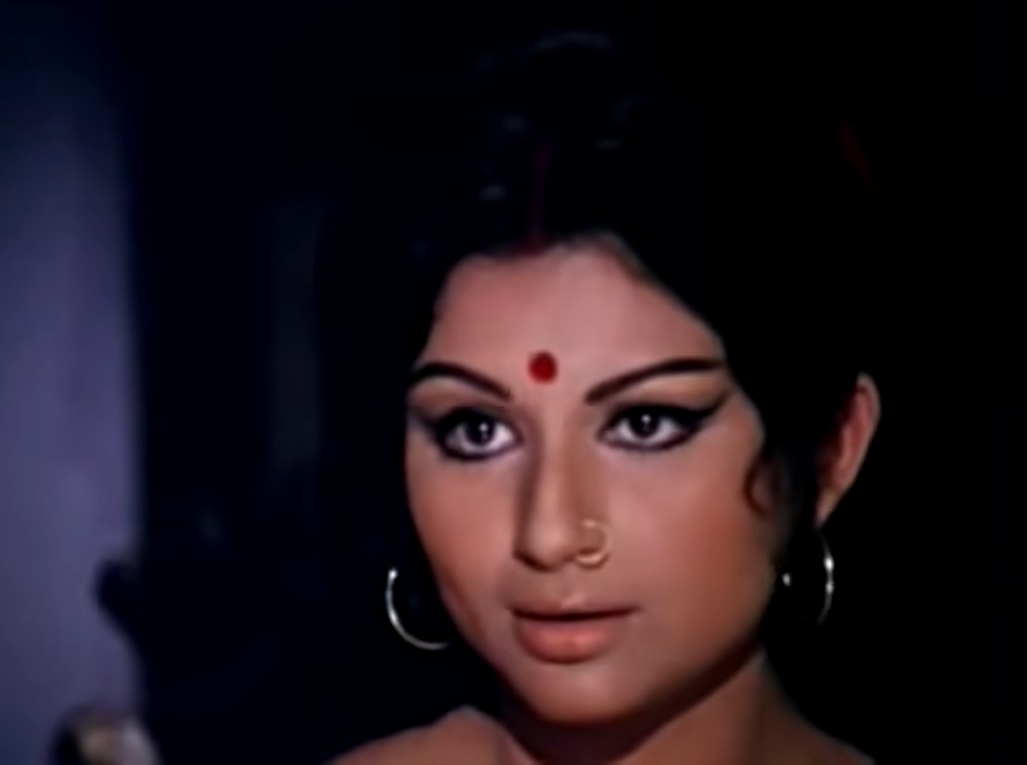Before at least 50% of you, the (likely Southeast Asian) readers of this essay, jump down my throat: this is a primer for everyone who, prior to her death last week, had never heard of Lata Mangeshkar. I am the first to admit no primer can possibly cover the breadth, genius, and influence of the playback singer known as the Nightingale of India. You and I have grown up on her voice, memorized her songs, attempted to and given up on mimicking her effortless soprano skills, listened to our families and friends try to do justice to her art at both celebrations and lazy Sunday teatimes. A multivolume tribute to her work might satisfy our needs but today, my goal is to provide a brief introduction to the legend we have lost. Note: I have selected her solo work, and songs that aren’t necessarily her most famous works, to illustrate her influence and range.
Let us begin with playback singing itself. Songs in Indian films—whether in Hindi, Tamil, Telugu, Marathi, Bengali, etc.—are almost never sung by the actors themselves. They are lip-syncing to a previously recorded song by a professional singer. Lata Mangheskar was born in 1929, in present-day Indore, to artist parents: her father was a classical singer and theater actor, her mother a Konkani musician. And while she received music lessons from her father—and acted in his plays—throughout her childhood, Mangeshkar did not begin formal training for a career as a singer till 1945, when she moved to Bombay, India’s film hub. Both Lata and her sister Asha (who went on to become an equally gifted playback singer in her own right) also acted as young women in films; their father’s death in 1942 forced them to do anything they could to ameliorate the family’s poverty. Mangeshkar hated acting, however, and found a way to approach the composer Ghulam Haider, renowned throughout India and Pakistan for his formative contributions to Hindi cinema in its infancy. Impressed by her determination and talent, he hired the teenage Lata to sing “Dil Mera Toda, Mujhe Kahin Ka Na Choda” in the 1948 film “Majboor.” Her grasp of melody is sweet, her tone plaintive—as the lyrics demand (“You broke my heart and left me high and dry”)—but her craft is clearly undeveloped.
1. “Aayega Aanewala”
It was just a year later, however, that Lata Mangeshkar first drew nationwide notice. The 1949 film “Mahal,” the directorial debut of Kamal Amrohi, with music by Khemchand Prakash, starred Madhubala, one of Hindi cinema’s biggest and brightest stars, who was only 16 herself when the film was made. “Aayega Aanewala,” lip-synced by the actress, is a very unusual song: the first three minutes and 16 seconds the actress is unseen, and the voice that draws actor Ashok Kumar to search for its source is simply reciting a poem. The song proper does not begin till 3:17. Early in her career Mangeshkar was known to slightly imitate the beloved Hindi film singer Noor Jehan, famous for her nasal vocals. “Aayega Aanewala” borrows from this style, especially in the first verse. But as her voice scales higher notes in the song, a glimmer of Lata Mangeshkar’s skill is audible. Prior to the blockbuster success of this song, playback singers were not considered artists, per se. They provided a service to a film, but not prized on par with actors and the director. A potent combination of luck, talent, and confidence pushed “Aayega Aanewala,” playback singing, and Lata Mangeshkar to the forefront of the audience’s imagination.
2. “Dil Jale to Jale”
“Dil Jale to Jale,” (“If the Heart Burns, Let It Burn”) from the 1954 film noir “Taxi Driver” (I highly doubt Martin Scorsese saw this one before he made his own), is yet another unusual song: heavily syncopated, jazzy, and Sheila Ramani, the lip-syncing actress onscreen, is styled like a sari-wearing version of Rita Hayworth in “Gilda” (1946). Mangeshkar was known for refusing what she called “nightclub songs;” her sister Asha usually wound up with these rejected assignments. But “Dil Jale To Jale” is restrained enough to be classical, while sexy without veering into Mangeshkar’s much-hated “vulgar” genre of songs.
3. “Ab Aage Teri Marzi”
The 1955 film “Devdas,” an adaptation of Bengali novelist Sarat Chandra Chattopadhyay’s eponymous novella, boasted more Mangeshkar magic. Directed by the celebrated Bimal Roy, the film chronicles the tragedy of the title character, played by Dilip Kumar, whose arrogance causes him to lose his childhood sweetheartc and descend into a hell of alcoholism and misanthropy. Sachin Dev Burman, the film’s music director, championed Mangeshkar; together they produced some of Hindi cinema’s finest scores. “Aage Teri Marzi” is a fast and joyous, yet insouciant plea (the charming lyrics written by Sahir Ludhianvi) from Chandramukhi the courtesan (Vyjayanthimala, in her first dramatic role) to Devdas (Kumar, further proving his ability to act via body language alone), brooding silently as the courtesan dances and sings in front of him and his friends. What I find particularly fascinating about this song is the influence of the music on the visual. That is, Vyjayanthimala, as both actress and dancer, had to listen to the song to align her performance with Mangeshkar’s performance, instead of the other way around, because Hindi film songs are recorded months before the film is actually shot. “Aage Teri Marzi” is just as beautiful on its own; with the visual it breathes new life into the Hindi film song.
4. “Naina Barse Rim Jhim”
Jumping ahead almost a decade, to 1964: Lata Mangeshkar is by now a household name, in constant demand for her services. “Woh Kaun Thi” (“Who Was She?”) was a smash hit thriller. “Naina Barse Rim Jhim” is classic Lata: soaring melancholy—practically messaging the heavens—careening through the snowy mountains of Kashmir, as Dr. Anand (Manoj Kumar) tries to get closer to her, having first encountered her in many different places, including, at the beginning of the film, giving her a lift to a cemetery (spooky!). Mangeshkar’s voice is equal parts haunting and haunted: she hints at a great love, one she has lost in tragic circumstances. The guitar strumming at the beginning of the song is unsettling, causing an undercurrent of tension bordering on frustration.
Note: Ultra Entertainment does not allow embeds of this performance so please click here to view.
5. “Piya Tose Naina Laage Re”
Author R.K. Narayan reportedly hated director Vijay Anand’s adaptation of the former’s novel “Guide.” The 1965 film starred Waheeda Rehman and the director’s brother, Dev Anand. S.D. Burman composed the film’s music, and, once again, showcased Mangeshkar’s ability to handle incredibly complex songs. “Guide,” if nothing else, is the source of a landmark—for Burman, for Mangeshkar, for Hindi cinema in general—song. “Piya Tose Naina Lage Re” is eight minutes and thirty seven seconds long, and illustrates the various phases of dancer Rosie’s (Rehman) career. It’s a fast song, heavy on tablas, with swaying strings that slide from confidence to trepidation and back. Mangeshkar’s voice is pitch-perfect as she tiptoes to the peaks of the melody, descends rapidly, covering a whole universe of sound and energy.
<span id=”selection-marker-1″ class=”redactor-selection-marker”></span>
6. “Dilbar Dil”
Music director R.D. Burman was a revolutionary. There’s no other way of putting it. The son of Sachin Dev Burman, Rahul Dev was a prodigy, writing songs for Hindi films when he was five years old (his composition was used by director Guru Dutt in his critically acclaimed 1957 film “Pyaasa”). His efforts were wholly unique, and influenced every single composer who came after him: pouring beer into bottles for a song, running a comb along a rough surface as part of an improvised ensemble, tinkling cups and saucers for a base melody. The music director arguably did his best work with Asha Bhosle, Lata’s sister, and his future wife. But there is an undeniable genius in “Dilbar Dil Se Pyare” from the 1971 film “Caravan” (pronounced “kahr-vaah”). It’s a song that sounds ideal for Bhosle, the queen of Western-style Hindi music, but Mangeshkar got this one; later she stated that such spirited songs were often more difficult to sing than traditional ones. “Dilbar Dil Se Pyare” is derived from a blend of influences: serpentine Arab melodies, Romani folk music (a particular favorite of Burman’s), upbeat guitars paired with Majrooh Sultanpuri’s pleading lyrics from a lovelorn woman to a man she knows doesn’t love her. And just try singing it! Like so many of Mangeshkar’s songs, I actually stop singing when she goes high, because it feels insulting to even try. The composition of “Dilbar Dil Se Pyare” leaves no room for error when it comes to breathing. To this day, it’s considered one of the hardest Hindi film songs to sing.
7. “Raina Beeti Jaye”
R.D. Burman and lyricist Anand Bakshi joined forces for director Shakti Samant’s “Amar Prem,” (“Eternal Love”) starring box office superstars Sharmila Tagore and Rajesh Khanna. Known as a “woman’s director” (a Hindi film term for movies showcasing women in staunchly feminist stories), Samant cast Tagore as a prostitute with a heart of gold, whose voice causes men to stop in their tracks. It’s almost a prayer, a message to a god who has long stopped caring for his devotee. Mangeshkar’s vocals convey purity pierced by pain: it’s as though Pushpa (Tagore) is a prisoner of her own agony. The melody format extends two-syllable words into hypnotic 12-syllable chants. From the 3:46 to 4:17 mark, the song—as high as I’ve heard Mangeshkar’s voice, clear as glass, go—reminds me of Leonard Cohen’s description of his father’s death: “an impossible” grief.
8. “Aaj Kal Pao Zameen Par”
The verses of “Aaj Kal Pao Zameen Par,” from the 1978 film “Ghar,” (“Home”) are surreal. Each word climbs higher than the one before. Legendary lyricist and screenwriter Gulzar, when not writing his own films, created some of Hindi cinema’s indelible gems with R.D. Burman. The latter didn’t even understand many of the words and phrases Gulzar used, but he knew how to do them justice. By then, Mangeshkar’s voice had matured—she was 43 when “Ghar” was made—and therefore perfectly suited to the actresses who had grown up lip-syncing her songs onscreen: Asha Parekh, Suchitra Sen, Rekha. The latter starred in “Ghar,” and her airy confidence lip-syncing Mangeshkar’s performance allows the song to transcend the known bounds of happiness. Underrated, but gorgeous.
Note: Ultra Entertainment does not allow embeds of this performance so please click here to view.
9. “Dikhayi Diye Yun”
“Dikhayi Diye Yun” is the only song in this primer written by someone who died hundreds of years before their work was used in a film. Mir Taqi Mir was an 18th century Urdu poet, prominent in Mughal India. Urdu itself was shaped by his extraordinary influence, and the universality of his ghazals make them relevant and beloved to this day. The 1982 film “Bazaar” (“The Market”) employed one of Taqi Mir’s couplets as the lyrics of its most memorable song. Once again, Lata Mangeshkar travels to the Mount Everest of melodies. There’s no parallel for her work in “Dikhayi Diye Yun,” partly because ghazals are often odes written about love (romantic and devotional), losing that love, and the beauty of love despite loss. Dilip Kumar once made a passing remark about Mangeshkar’s poor Urdu pronunciation. She immediately got a tutor, and the results of her work are evident here. As in “Aaj Kal Pao Zameen Par,” her voice, while still capable of beauty and naked emotion, was by then elegant, rich, having shed the thinness music directors had dismissed her over in the 1940s.
Note: Ultra Entertainment does not allow embeds of this performance so please click here to view.
10. “Paani Paani Re”
I consider the mid-1990s the end of Mangeshkar’s career. She continued singing into the 2010s, but for me, her age caught up with her talent by the end of the 20th century. We have thus arrived at the pièce de résistance of this primer: in 1996 Gulzar wrote and directed “Maachis” (“Matchsticks”), a poignant thriller about the Sikh insurgency in 1980s Punjab. The film was also his music director’s debut. Vishal Bharadwaj had, some years earlier, met Gulzar in a New Delhi sweets shop. They’ve worked together ever since; Gulzar has provided the lyrics for almost all of his protégé’s films, including “Haider” (Bharadwaj’s riff on “Hamlet”), “Maqbool” (“Macbeth”), “Omkara” (“Othello”) and “Saat Khoon Maaf.” The minimalism of “Paani Paani Re” is mesmerizing. At most there’s a bass guitar, wind chimes, muted drums, mournful cellos, and a single shehnai. Mangeshkar’s voice is the real instrument here. Close your eyes and you can hear a river of tears, borne of heartbreak, winding up a mountain, then cascading down the same peak, its flow echoing in the abandoned valley. “Paani Paani Re” conveys the weight in Mangeshkar’s voice: you can feel it droop. She is by no means unskilled in “Maachis”—I chose this song for its undeniable beauty—and the sag in her voice actually suits her here, because this song is the soul of loss. Virender Kaur (Tabu) is singing about her village, from which she has been expatriated, and the alien, sorrowful transience that is now her way of life. Mangeshkar’s elongation of “paani” is enough to make you want to weep too, and not just because we’ve lost Mangeshkar herself.












